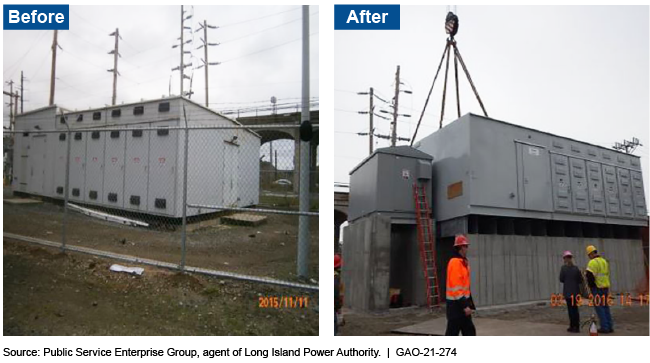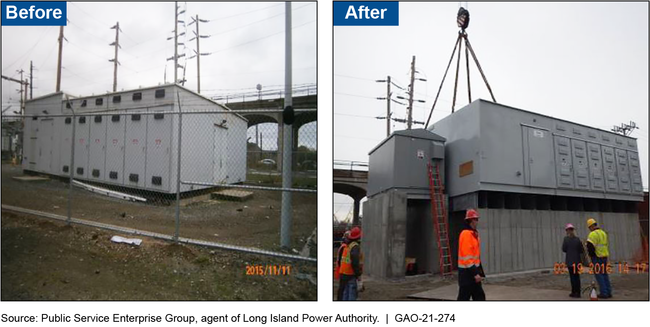Electricity Grid: Opportunities Exist for DOE to Better Support Utilities in Improving Resilience to Hurricanes
Fast Facts
Hurricanes are a leading cause of major power outages in the U.S., impacting millions of customers in recent years. Utilities in hurricane-affected states have invested in ways to better equip their grids to withstand and rapidly recover from hurricanes. For example, some utilities have elevated equipment to protect grid infrastructure from flooding.
The Department of Energy and its National Laboratories are developing planning tools, such as metrics to track grid resilience. However, we recommended that DOE create a plan to better guide these efforts and to better inform utilities about available resources at its National Labs.
Elevated substation in New York to protect from flooding

Highlights
What GAO Found
Since 2012, utilities have taken steps to improve grid resilience to severe hurricanes, such as (1) implementing storm hardening measures to enable the grid to better withstand the effects of hurricanes; (2) adopting technologies to enhance operational capacity and help quickly restore service following disruptions; and (3) participating in mutual aid programs with other utilities and training and planning exercises. For example, utilities have implemented storm hardening measures that include elevating facilities and constructing flood walls to protect against storm surges. Utilities have also adopted technologies that enhance communication capabilities and monitor systems to detect, locate, and repair sources of disruptions. However, these utilities reported challenges justifying grid resilience investments to obtain regulatory approval, and some utilities have limited resources to pursue such enhancements.
Example of Hurricane Resilience Improvement: Elevated Substation

Various federal agencies can provide funding for efforts to enhance grid resilience to hurricanes, including the Department of Agriculture (USDA) and the Federal Emergency Management Agency (FEMA). However, eligibility for most federal funding for grid resilience, including some USDA and FEMA funding, is limited to publicly owned utilities and state, tribal, and local governments. The Department of Energy (DOE) does not provide direct funding for grid resilience improvements, but it has efforts under way, including through its National Laboratories, to provide technical assistance and promote research and collaboration with utilities. DOE has also initiated preliminary efforts to develop tools for resilience planning, including resilience metrics and other tools such as a framework for planning, but DOE does not have a plan to guide these efforts. Without a plan to guide DOE efforts to develop tools for resilience planning, utilities may continue to face challenges justifying resilience investments. In addition, DOE lacks a formal mechanism to inform utilities about the efforts of its National Laboratories. Such a mechanism would help utilities leverage existing resources for improving grid resilience to hurricanes.
Why GAO Did This Study
Hurricanes pose significant threats to the electricity grid in some U.S. coastal areas and territories and are a leading cause of major power outages. In recent years, hurricanes have impacted millions of customers in these areas. Adoption of technologies and other measures could improve the resilience of the grid so that it is better able to withstand and rapidly recover from severe weather; this could help mitigate the effects of hurricanes.
This report examines (1) measures utilities in selected states have adopted to enhance grid resilience following major hurricanes since 2012 and any challenges utilities face funding such measures; and (2) federal efforts to support the adoption of measures to enhance grid resilience to hurricanes and any opportunities that exist to improve these efforts. For this report, GAO assessed agency and industry actions; reviewed relevant reports, policies, and documents; and interviewed federal, industry, and local officials.
Recommendations
GAO recommends that DOE (1) establish a plan to guide its efforts to develop tools for resilience planning, and (2) develop a mechanism to better inform utilities about grid resilience efforts at the National Laboratories. DOE agreed in principle with these recommendations, but its proposed actions do not fully address GAO's concerns.
Recommendations for Executive Action
| Agency Affected | Recommendation | Status |
|---|---|---|
| Department of Energy |
Priority Rec.
The Secretary of Energy should establish a plan, including timeframes as appropriate, to guide the agency's efforts to develop tools for resilience planning, such as performance measures for resilience, a framework for resilience planning, and additional information on the cost of long-term power outages. (Recommendation 1) |
In June 2021, DOE officials told us that its Office of Cybersecurity, Energy Security and Emergency Response (CESER) is establishing a plan of action for energy sector risk management, building on several completed and ongoing elements led by DOE program offices for resilience planning, including tools for resilience planning, frameworks for resilience planning, and information on the long-term costs of power outages. In April 2024, DOE-CESER told us it aims to complete this plan by September 30, 2024, pending availability of funds. As of January 2025, this plan was not complete.
|
| Department of Energy | The Secretary of Energy should take steps to better leverage the National Laboratories' emerging grid resilience efforts and technologies by developing a formal mechanism to share this information with utilities. (Recommendation 2) |
In February 2022, DOE officials provided us with a number of examples of national laboratories collaborating with specific utilities. In order to fully implement this recommendation, DOE needs to develop a formal mechanism for sharing information with utilities. In April 2024, DOE officials told us they are supporting the development of an Energy Threat Analysis Center, which will serve as a mechanism for such information sharing. They estimated it would be completed by September 2024. As of January 2025, it was not complete.
|
